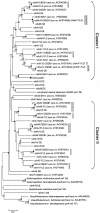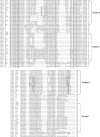Multiple nonidentical reductive-dehalogenase-homologous genes are common in Dehalococcoides
- PMID: 15345412
- PMCID: PMC520921
- DOI: 10.1128/AEM.70.9.5290-5297.2004
Multiple nonidentical reductive-dehalogenase-homologous genes are common in Dehalococcoides
Abstract
Degenerate primers were used to amplify large fragments of reductive-dehalogenase-homologous (RDH) genes from genomic DNA of two Dehalococcoides populations, the chlorobenzene- and dioxin-dechlorinating strain CBDB1 and the trichloroethene-dechlorinating strain FL2. The amplicons (1,350 to 1,495 bp) corresponded to nearly complete open reading frames of known reductive dehalogenase genes and short fragments (approximately 90 bp) of genes encoding putative membrane-anchoring proteins. Cloning and restriction analysis revealed the presence of at least 14 different RDH genes in each strain. All amplified RDH genes showed sequence similarity with known reductive dehalogenase genes over the whole length of the sequence and shared all characteristics described for reductive dehalogenases. Deduced amino acid sequences of seven RDH genes from strain CBDB1 were 98.5 to 100% identical to seven different RDH genes from strain FL2, suggesting that both strains have an overlapping substrate range. All RDH genes identified in strains CBDB1 and FL2 were related to the RDH genes present in the genomes of Dehalococcoides ethenogenes strain 195 and Dehalococcoides sp. strain BAV1; however, sequence identity did not exceed 94.4 and 93.1%, respectively. The presence of RDH genes in strains CBDB1, FL2, and BAV1 that have no orthologs in strain 195 suggests that these strains possess dechlorination activities not present in strain 195. Comparative sequence analysis identified consensus sequences for cobalamin binding in deduced amino acid sequences of seven RDH genes. In conclusion, this study demonstrates that the presence of multiple nonidentical RDH genes is characteristic of Dehalococcoides strains.
Figures



References
-
- Adrian, L., U. Szewzyk, J. Wecke, and H. Görisch. 2000. Bacterial dehalorespiration with chlorinated benzenes. Nature 408:580-583. - PubMed
-
- Adrian, L., and H. Görisch. 2002. Microbial transformation of chlorinated benzenes under anaerobic conditions. Res. Microbiol. 153:131-137. - PubMed
-
- Banerjee, R., and S. W. Ragsdale. 2004. The many faces of vitamin B12: catalysis by cobalamin-dependent enzymes. Annu. Rev. Biochem. 72:209-247. - PubMed
-
- Beinert, H. 2000. Iron-sulfur proteins: ancient structures, still full of surprises. J. Biol. Inorg. Chem. 5:2-15. - PubMed
Publication types
MeSH terms
Substances
Associated data
- Actions
- Actions
- Actions
- Actions
- Actions
- Actions
- Actions
- Actions
- Actions
- Actions
- Actions
- Actions
- Actions
- Actions
- Actions
- Actions
- Actions
- Actions
- Actions
- Actions
- Actions
- Actions
- Actions
- Actions
- Actions
- Actions
- Actions
- Actions
LinkOut - more resources
Full Text Sources

